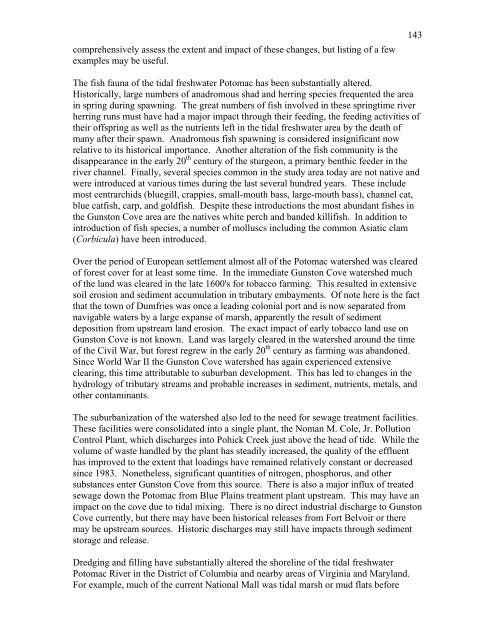NEW: Annual Report - George Mason University
NEW: Annual Report - George Mason University
NEW: Annual Report - George Mason University
You also want an ePaper? Increase the reach of your titles
YUMPU automatically turns print PDFs into web optimized ePapers that Google loves.
comprehensively assess the extent and impact of these changes, but listing of a few<br />
examples may be useful.<br />
The fish fauna of the tidal freshwater Potomac has been substantially altered.<br />
Historically, large numbers of anadromous shad and herring species frequented the area<br />
in spring during spawning. The great numbers of fish involved in these springtime river<br />
herring runs must have had a major impact through their feeding, the feeding activities of<br />
their offspring as well as the nutrients left in the tidal freshwater area by the death of<br />
many after their spawn. Anadromous fish spawning is considered insignificant now<br />
relative to its historical importance. Another alteration of the fish community is the<br />
disappearance in the early 20 th century of the sturgeon, a primary benthic feeder in the<br />
river channel. Finally, several species common in the study area today are not native and<br />
were introduced at various times during the last several hundred years. These include<br />
most centrarchids (bluegill, crappies, small-mouth bass, large-mouth bass), channel cat,<br />
blue catfish, carp, and goldfish. Despite these introductions the most abundant fishes in<br />
the Gunston Cove area are the natives white perch and banded killifish. In addition to<br />
introduction of fish species, a number of molluscs including the common Asiatic clam<br />
(Corbicula) have been introduced.<br />
Over the period of European settlement almost all of the Potomac watershed was cleared<br />
of forest cover for at least some time. In the immediate Gunston Cove watershed much<br />
of the land was cleared in the late 1600's for tobacco farming. This resulted in extensive<br />
soil erosion and sediment accumulation in tributary embayments. Of note here is the fact<br />
that the town of Dumfries was once a leading colonial port and is now separated from<br />
navigable waters by a large expanse of marsh, apparently the result of sediment<br />
deposition from upstream land erosion. The exact impact of early tobacco land use on<br />
Gunston Cove is not known. Land was largely cleared in the watershed around the time<br />
of the Civil War, but forest regrew in the early 20 th century as farming was abandoned.<br />
Since World War II the Gunston Cove watershed has again experienced extensive<br />
clearing, this time attributable to suburban development. This has led to changes in the<br />
hydrology of tributary streams and probable increases in sediment, nutrients, metals, and<br />
other contaminants.<br />
The suburbanization of the watershed also led to the need for sewage treatment facilities.<br />
These facilities were consolidated into a single plant, the Noman M. Cole, Jr. Pollution<br />
Control Plant, which discharges into Pohick Creek just above the head of tide. While the<br />
volume of waste handled by the plant has steadily increased, the quality of the effluent<br />
has improved to the extent that loadings have remained relatively constant or decreased<br />
since 1983. Nonetheless, significant quantities of nitrogen, phosphorus, and other<br />
substances enter Gunston Cove from this source. There is also a major influx of treated<br />
sewage down the Potomac from Blue Plains treatment plant upstream. This may have an<br />
impact on the cove due to tidal mixing. There is no direct industrial discharge to Gunston<br />
Cove currently, but there may have been historical releases from Fort Belvoir or there<br />
may be upstream sources. Historic discharges may still have impacts through sediment<br />
storage and release.<br />
Dredging and filling have substantially altered the shoreline of the tidal freshwater<br />
Potomac River in the District of Columbia and nearby areas of Virginia and Maryland.<br />
For example, much of the current National Mall was tidal marsh or mud flats before<br />
143
















